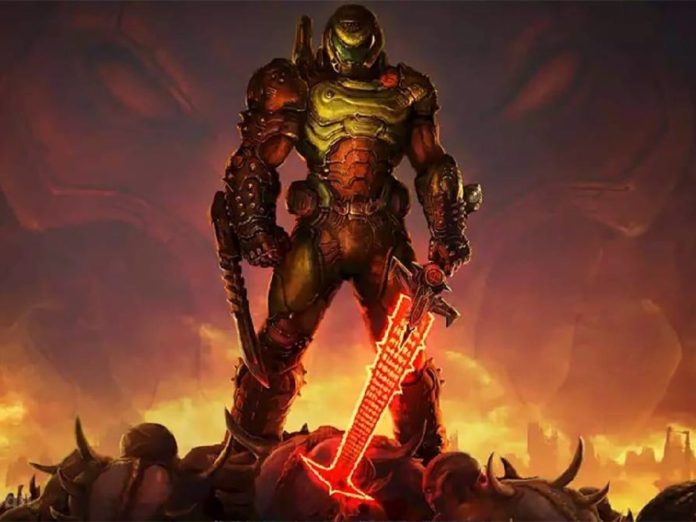It’s simple to understand why Doom is among the most well-known and recognizable video game IPs. For those who enjoy video games in general, the journey of Doom games through the ages as it underwent various gameplay evolutions and changes is truly fascinating. A historic franchise, Doom, along with Wolfenstein, pioneered the evolution of the first-person shooter genre.
Every game in the Doom series has made an impact in some way throughout it’s history, which spans several decades and includes innovations that have since become standards of the first-person shooter genre. Here is a list of every game in the series, arranged according to the order in which they were released, for die-hard gamers who want a thorough look at Doom’s history. So, keep reading.
All Doom Games in Order of Release Date
The Doom IP is owned by Id Software, which also developed each game in the series. Their formula is simple but efficient. In these first-person shooters, you take control of the ultimate badass. A space marine known as “The Doom Guy” “Fights Like Hell” for humanity.
Players battle the forces of Hell overall. There is typically a sizable arsenal of weapons, each with a wide range of capabilities and advantages.
In addition, The Slayer has a futuristic suit called the Praetor Suit. In some video games, it can be upgraded to provide more defensive, offensive, and mobility benefits. Since Doom games tend to be fast-paced, chaotic, and furious, mobility is essential in most of them. To defeat the hellspawn, players must move quickly and constantly switch between weapons.
You must complete numerous levels because of the linear design of the game. These levels act as mazes with central areas, auxiliary areas, collectibles, and concealed secrets.
The Doom series is divided into three parts overall. The Classic Series ran from 1993 to 1997, the Doom 3 era ran from 2004 to 2012, and the rebooted series ran from 2016 to till date. Modern consoles support all games from the main series.
Classic Era
-
Doom – 1993 (Main series)
In 1993, Doom made it’s debut on MS-DOS systems. There are various editions and ports available for Xbox One, PS4, Nintendo Switch, Android, and iOS.
The FPS featured 2D character models and early 3D graphics. Unidentified space marine ran past numerous military installations in Hell and installations on Mars’ moons. There were different episodes in every dungeon, and the last area featured a boss battle.
Managing health, armour, and ammo was also necessary to complete each level. Enemies were strong, numerous, and vicious. The arsenal contained a gun, a plasma rifle, power-ups, and the formidable BFG 9000.
Although it wasn’t as important as the gameplay, the plot was still present. The lore of the game was presented in brief text passages interspersed between it’s three episodes. The “Doom Guy” is sent on a “suicide” mission to defend a combat force on various military bases after he attacked a superior officer.
-
Doom II: Hell on Earth – 1994 (Main Series)
In 1994, Hell on Earth made it’s debut for MS-DOS systems, and in 1995, it did so for Macintosh PCs. You can currently find it on Windows, iOS, Android, PS4, Xbox 360, Xbox One, and Nintendo Switch.
In addition, developers enhanced the engine and produced more intricate levels using new computer hardware. Every level had more demons to defeat, and the dungeons grew wider and less linear.
There were 32 levels in the gameplay, though two of them were hidden. Players discovered more than one boss fight, a wider arsenal, and twice as many different types of enemies. Particularly, Doom II popularised the double-barreled shotgun.
The events of Doom I are continued in Doom II’s storyline. A portal to Earth is opened by new demons after the Slayer vanquishes the Spider Mastermind. Massive spacecraft were used by the survivors to flee Earth, but the last spaceports were overrun by demons. The Space Marine is the only person who can defend humanity from the armies of Hell.
-
Master Levels for Doom II – 1995
The first Doom II expansion was made available in 1995 by iD Software. Compared to the base game, Master Levels added 20 new levels with tougher enemies.
-
Thy Flesh Consumed (The Ultimate Doom) – 1995 (Doom II Expansion)
As a post-launch expansion, the fourth episode of the original game made it’s debut. The original Doom version does not have it. Only the Ultimate Doom version does. Having said that, Windows consoles can purchase Ultimate Doom on Steam.
In 1995, Thy Flesh Consumed made it’s debut. In this prequel to Doom II, the Slayer battles an invasion of demons on Earth. At the time, Id Software was working on the Quake series, so outside studios made the expansion. The expansion is more difficult to play than the base game.
Finally, Ultimate Doom is no longer shareware with an open-source code. It is the original game’s retail re-release.
-
Final Doom – 1996 (Third-party Entry)
Under the direction of iD Software, the modding group TeamTNT released Final Doom in 1996. At the time, the Quake saga was being developed by the original developers.
MS-DOS, Macintosh PCs, and PlayStation saw the release of Final Doom. The Nintendo Switch, Xbox One, and PlayStation 4 platforms currently support it.
Two standalone Doom II episodes are collected in the third-party game. Every episode functions as it’s own campaign. Avenging fallen allies is the focus of the first section, while shutting the gates of Hell is the focus of the second.
The game has 32 levels and Doom II is the game’s prequel. Although it’s more challenging than previous games, the gameplay is almost identical to Doom II. Final Doom, as an illustration, lacks life regeneration.
-
Doom 64 – 1997 (Third-party Entry)
Nintendo 64’s Doom 64 made it’s debut in 1997. In 2020, Bethesda released a remastered port for Windows, Nintendo Switch, PS4, Google Stadia, and Xbox One.
The gameplay of Doom 64 is comparable to that of earlier games. Players progress through 28 levels, 4 secret levels, and hordes of demons. The difference is that the game’s new engine significantly enhanced the graphics, character models, weapon models, and performance.
After stopping the Hell invasion on Hearth, the Doom Guy is followed in the story. The space marine is sent on a new mission to a Union Aerospace Corporation base to look for a dangerous being. The new enemy seems to have high radiation levels, corrupted tissue, and the ability to raise the dead.
All of this, though, was a plan to trap the Doom Guy in Hell. In reality, they were trapped in the underworld with the Slayer when they believed they had captured the marine in the eternal fires. As a result, at the game’s conclusion, the Doom Guy decides to stay in Hell forever to ensure no demon ever rises.
Doom 3 Era
-
Doom 3 – 2004 (Main Series)
In 2004, the Windows version of Doom 3 (DOOM) was released. Later, it was made available for Xbox, Linux, and macOS X. It’s the first reboot in the series, with a new plot but the same lore and gameplay.
In the year 2145, the plot sends the Doom Guy to Mars. Teleportation, advanced weapons, and bioweaponry are being studied by a military conglomerate. These experiments create a portal to Hell, which causes a demon invasion of Mars. Naturally, the Slayer vanquishes the demon army.
The main objective of the narratively focused campaign in Doom 3 is to eliminate numerous enemies and make it to the level’s exits. Along with NPCs, the game includes inventory items, objectives, and key information.
The shooting is more accurate than ever. There are ten weapons at your disposal, including the BFG 9000 and some untested plasma weapons. Enemies come in a wide variety, each with their own abilities, weaknesses, and behaviours.
Additionally, the game incorporates horror elements to move the series’ setting into a horror or survival genre. Players might have to decide between holding a flashlight or a weapon, for instance.
Finally, Doom 3 offers a variety of 4-player multiplayer deathmatch modes. Later, the community modified the feature to support a maximum of sixteen players.
-
Doom 3: Resurrection of Evil – 2005 (Doom 3 Expansion)
The Doom 3 expansion Resurrection of Evil is created by Nerve Software. It was released for Windows and Xbox in 2005.
Twelve single-player levels, six new enemies, and several new multiplayer maps are included in the sequel. The double-barreled shotgun from Doom II was also brought back.
Two new features are also added. The first is the Ionized Plasma Levitator, a tool that can pick up and move objects as well as tiny fire projectiles. Interestingly, the Gravity Gun from Half-Life 2 is quite similar, and both games came out the same year.
The second characteristic is the Bloodstone and the Heart of Hell, two demonic artefacts with three special powers. When the Slayer defeats three bosses, these become available.
-
Doom II: No Rest for the Living – 2010 (Doom II Expansion)
The second Doom II expansion is titled No Rest for the Living. In 2010, it made it’s Xbox 360 debut. The pack is made by Nerve Software with the assistance of iD Software.
There are 8 new levels and 1 secret level in the expansion. It happens after Doom II’s campaign and serves as a tribute to the first Doom.
-
Doom 3: BFG Edition – 2012 (Remaster and Bundle)
Doom 3 has been remastered and is available as The BFG Edition. It was released in 2012 for Windows, Xbox 360, and PlayStation 3.
BFG adds checkpoints, better audio, more horror sound effects, and improved graphics. Support for 3D displays and HDMI are additions. It also added the simultaneous use of weapons and the flashlight in gameplay.
The BFG Edition is also a package that comes with:
- Doom 3
- Doom 3: Resurrection of Evil
- Doom 3: The Lost Mission (Doom 3 cut-content of 8 extra levels)
- The Ultimate Doom
- Doom II: Hell of Earth
- Doom II: Master Levels of Doom
- Doom II: No Rest for the Living
- Doom Classic Complete – 2012 (Bundle)
In 2012, the PS3 version of Doom Classic Complete made it’s debut. It’s currently accessible through Steam.
It consists of:
- Ultimate Doom
- Doom II
- Master Levels for Doom II
- Final Doom
Rebooted Series
-
Doom – 2016 (Main Series)
The series was relaunched in 2016 with Doom. The only developer is iD Software, and Bethesda Softworks is now the publisher for this game.
To combat the forces of Hell, a fresh Doom Slayer reappears. On the other hand, demons and the dead are attacking a UAC’s Mars facility. The Slayer must drive the hellspawn back to their proper location.
Doom 2016 has a system for character development, environmental exploration, improved mobility skills, and a large arsenal. It also has numerous enemies, each of whom has different skills, traits, and weak points.
The “Glory Kills” system was also introduced by the game. The Slayer can use a unique melee attack to kill an enemy after stun-damaging it sufficiently. A glory kill replenishes ammo.
Similarly, you can use a chainsaw to kill the majority of weak enemies or a wounded strong enemy. Instead of healing, it replenishes ammunition.
With these two additions, along with improved mobility, Doom evolved into hectic micromanagement of HP, Ammo, and chainsaw fuel. Aside from that, the campaign, soundtrack, and graphics were top-notch, the best in the series’ history.
-
Doom VFR – 2017 (VR Spin-off)
Doom VFR by iD Software is the first Doom VR game. It made it’s debut in 2017 on Windows and PlayStation VR.
But you can’t play as the Slayer. Instead, you take on the role of a cybernetic survivor who fights against a demon invasion of Mars as a UAC soldier. It’s a canonical story that takes place after Doom II.
You can move around the UAC facility, teleport, use a jet strike, and engage in combat using a variety of weapons, thanks to the gameplay. The game is challenging, and VR games can be awkward, so you’d need to adjust the major binding to make it function for you.
It can be a fantastic game that is both brutal and fluid after you adjust the controllers. While the Doom series calls for quick movement, turning and moving in VR is difficult. If you already own a VR system and you play Doom 2016, you should give it a shot.
-
Doom Re-release – 2019
Doom, Doom II, and Doom 3 were re-released by Bethesda in 2019 for iOS, Android, Xbox One, PS4, Windows, and Nintendo Switch.
-
Doom Eternal – 2020 (Main series)
In 2020, Doom Eternal made it’s PlayStation 4, Xbox One, Windows, and Google Stadia debuts. There is also a new-gen console-optimized version available.
The Doom 2016 formula was enhanced by Doom Eternal, which also included new components. The majority of weapons, for example, have two variations and two ways to level up. As each enemy has unique weaknesses, you would need to use every weapon.
Second, the Praetor Suit comes with a number of upgrades, perks that improve mobility, the fire thrower, grenades, and more.
Thirdly, you can always have access to three extra benefits. Through exploration, you can acquire these runes, which significantly alter and enhance your gameplay.
In addition, the game has a system that shows the Doom Guy’s damage to the enemies. You can watch the monster’s flesh, bones, and armour crumble as you chip away at it.
Although the game is linear, the maps are large and packed with hidden objects. Unlocking the complete original Doom game is one of these secrets. Speaking of the hub, The Fortress of Doom, it has some secrets as well. You can find some weapons, skins, and upgrades there.
Additionally, you can relax while listening to the Doom soundtrack and decide whether to replay earlier missions with or without cheat codes. Even better, play the original Doom in the Slayer’s room.
These factors, combined with numerous platforming segments, produced the most frantic shooter you can play. It’s quick, explosive, difficult, and challenging to master. Also, it is very addictive.
The Doom Guy is on a quest to stop Hell’s invasion of Earth when the story picks up. The Slayer thwarts the Maykr alien’s plans to wipe out humanity. In this gameplay, you learn about several pieces of lore, such as the history of the Slayer, the divine Mayrk alien race, and so on, at once.
The “Battle mode” multiplayer mode is another feature of the game. It produces pairings of a Doom Slayer and a demon.
-
Doom Eternal: The Ancient Gods Part I – 2020
The narrative of 2016 Doom is continued in Doom Eternal. It requires the player to play the Doom Slayer once more. However, Eternal tells it’s story in a more conventional and straightforward way as opposed to the incredibly minimalistic approach in Doom 2016.
The Slayer’s victory over the Icon of Sin puts an end to Doom Eternal and stops Hell’s advance on Earth.
But there was a cost to the victory. The Maykr race’s home heaven, Urdak, was conquered by the forces of Hell. They used the energy produced by suffering souls to power their technology, so they needed Hell to succeed on Earth.
The Slayer embarked on a mission to save the divine race with the help of scientist Samuel Hayden and other allies.
The expansion’s three levels of gameplay include a number of new enemies.
-
Doom Eternal: The Ancient Gods Part II – 2021
In 2021, The Ancient Gods Part II made it’s debut. The Dark Lord is finally vanquished by the Doom Slayer in Immora, the seat of Hell.
The environment presents some of the wackiest and most original scenarios the series has ever seen. The Doom Slayer encounters numerous gods, travels to various planets and dimensions, and learns important lore.
The expansion includes four new levels, a number of new enemies, an agonizing final battle, and a new weapon.
Wrapping Up!
And those are all the Doom games that have been made public so far!
Please check back occasionally, as we’ll make sure to update this list as new Doom titles are released.
Other Technical Reviews:- Reviews














